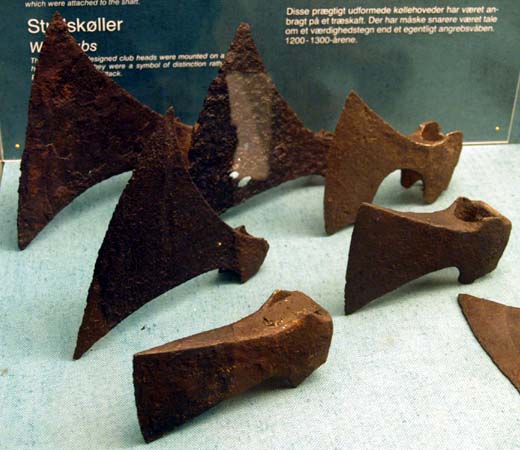This is a 'Norse styled' small tool axe, which I finished the rough forging on yesterday:
 |
| Small tool axe - shown life sized |
I would refer readers to a couple of earlier posts on Norse axes :
http://warehamforgeblog.blogspot.ca/2008/07/using-source-norse-ship-tools.html
http://warehamforgeblog.blogspot.ca/2008/07/norse-woodworking-axes.html
 |
| 3/4 view - enlarged version |
 |
| Side view - enlarged |
 |
| Top view, showing thickness variations - enlarged |
- total 18 cm long,
- blade is 7.5 cm
- the base of the blade is 1.5 cm thick x 4 cm wide
- the eye is about 3 cm long x 2.5 cm wide x 4.2 cm tall
- as rough forged the weight is 695 gm (expect some loss with final shaping and sharpening)
The blade has an inset carbon steel wedge welded in. (The small surface crack seen mid way along the fold and weld will be ground out when the finished profile grinding is undertaken).
The eye has been reshaped (via drifting and hammering over the drift) to closer to the correct D profile. There is a slight point drawn down to the bottom side of the eye, while the top line is left straight.
 |
| Group of Viking Axe axes, weapons to the rear, two tool axes at the front |
http://forums.dfoggknives.com/index.php?showtopic=17953
Looking at the artifacts, you clearly see the difference in shapes between the small tool axe (likely intended as a splitting axe, given the shape) and my forging.
Jim and Jeff Pringle have been able to look at a number of heavily corroded artifact samples (not the nice clean 'perfect' ones usually on display like those above!). The corroded axes clearly show the welding lines. This indicates the two main production methods use by the Norse were:
- cut to Y and fold for peen
- draw and profile bar end, fold and lap weld at base of blade / eye
If Jim's original work had any limits, it was that he was (understandably) working with modern mild steel, and also using (very) modern tools (gas forges / large anvils and vices / power hammers).
There are two cautions here:
- First is the dynamic of working with a bloomery / wrought iron, which has pronounced grain and potential failure lines. If anything however, Jim's methods *reduce* those potential problems over other possible production methods. (Especially the use of the 'split and drift' method I have used in the past (see the Norse Tool Axes reference above).
- Second is the limits imposed by actually available Norse blacksmithing tools. This is a thorny problems for two reasons :
- The available tool sets are limited number, and primarily intended as grave goods (so may or may not represent actual 'working' tool sets). It should be remembered the old axim 'Absence of proof - is NOT proof of absence'.
- Norse smiths *obviously* were fully able to utilize both the ,split and lap, and ' draw profile and lap' methods - and extremely well as the artifacts prove.




















No comments:
Post a Comment